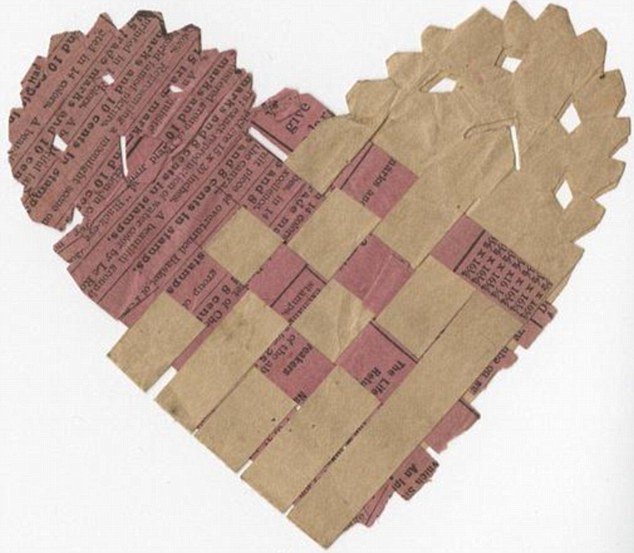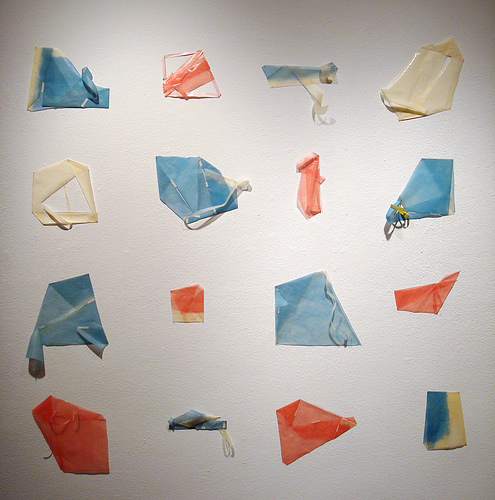[Full disclosure: The author and the interviewee have more than transformative experiences through their love of birds and participation in the Postcard Collective in common. Together they have visited Maine twice (though the author has no recollection of seeing the Swainson's Thrush), camped in Michigan's Upper Peninsula, and spent numerous hours discussing their respective artwork. ]
The first time I saw Hannah Barnes draw a bird was on a napkin at a local bar. They have since appeared on many birthday cards and even an abstract rendition in one of her paintings (that I meticulously searched her website for and could not find). Despite knowing Hannah for the last seven years, I learned so much more about her working process and influences through this interview. There is nothing like a formal structure to better understand someone's artwork you think you knew well.
Jacinda Russell: Tell me about your relationship with birds as they have appeared on and off in your artwork and are featured prominently in both your entries for the Postcard Collective.
Hannah Barnes: I would consider myself a novice birder at best. I don’t know very much about birds, but I do credit them for some of my most profound moments in the wilderness. They have been adept at teaching me how to pay attention. Trying to pick out a tiny yellow warbler high up among a dense mass of leaves, patiently, without moving, with one’s senses fully open – this sort of ‘present-moment awareness’ is profound and transformative.
Both of my grandfathers are amateur birders, but I knew little about birds until I moved to Maine and had the opportunity to spend time in the wilderness. The first bird I learned about was the Swainson’s Thrush. It’s a small, unremarkable looking brown bird that is very difficult to spot, as it blends in very well with its habitat. Although it isn’t much to look at, the thrush has a distinctive musical, flute-like call, considered by some birders to be the most beautiful of all birdsongs. It can be heard throughout the summer in the wooded areas of Maine. I think the thrush somehow sneakily ‘throws’ its voice, because although it spends most of its time hopping along the forest floor, its song always seems to be coming from the overhead canopy.
Bird Love Token (Image provided by Hannah Barnes)
JR: You are one of the few people that have submitted postcards that incorporate interactivity as the main means of expression. A story is unveiled at the turn of a dial resulting in a cyclical presentation where the viewer decides where it must end or begin. What is your interest in this format?
HB: Part of what excites me about the Postcard Collective is the format itself. These days, it seems the postcard, like most hand-mailed correspondence, is becoming an increasingly antiquated form of communication (evidenced by the fact that in 2011, the USPS nearly went through with a plan to close more than 3,700 struggling branches). I feel mournful about this because when I was a teenager, letter writing was my favorite way to communicate with my friends. I even had an Australian pen-pal. I loved writing and receiving letters and postcards; I spent hours crafting envelopes from scratch, embellishing them with elaborate text, and filling them with mementos, letters, and drawings. When I first approached creating an artist postcard for the Collective, my natural instinct was to channel these qualities of handicraft and personal exchange.
The simple interactive, handmade format of my cards reminds me of objects and sentiments from a bygone era, much like the postcard itself. The turning paper wheel I’ve used in my past cards is a simple mechanism that offers a narrative ‘page-turning,’ ah-hah/surprise device, as well as an element of play, novelty, and interactivity. As a kid, I loved simple interactive wooden and paper games and toys like Jacob’s ladders, jigsaw puzzles, origami, and pop-up books; the moving-part card works (I hope) in a similar way.
Vintage Valentines (Images provided by Hannah Barnes)
JR: These are sad anecdotes in which humans kill birds maliciously or unintentionally. You conceal their deaths until the last few words spin visibly in the opening. There is excitement in turning the dial (as an element of play) yet the content contradicts this action. Ultimately, I am left despising the people that would kill an animal in these ways. What would you like the viewer to take from this and why was it important to make two postcards that drive these points home?
HB: Birds seem to have so much to tell us about ourselves, and about our planet. We have seen numerous species become extinct in modern history – over 190 since 1500. Many of these extinctions can be attributed directly to human activity – our arrogance toward other species, our disregard for nature, and our failure or refusal to understand its laws of interdependence. I suspect that if we could pay more attention to them, birds would have many answers for us about how and where we are going wrong as humans. Rachel Carson’s research revealed how eagles and falcons were being pushed to the brink of extinction as a result of pesticide use; yet decades later, pesticides continue to be responsible for problems in human health and the environment.
I suppose that’s what my postcards, which recollect true stories, are about. They convey the hubris of our species and our failure to listen to one of nature’s most vocal harbingers. My first postcard tells a story of 100 tropical canaries left to freeze in in the cold on inauguration day. I think the symbolism is profound. I’d like to keep doing tragic bird stories as long as I can find them. As for the interactive element, I’m fond of how the reader/viewer is in charge of turning the wheel – it’s as if the card asks each recipient to acknowledge his or her part in the unfolding of the story.
Hannah Barnes, Fragments, 2008
JR: Artists that submit work that varies radically from their normal practice intrigue me. As an abstract painter and drawer you are producing postcards that are straightforward representations inspired by early 20th century drawing and typology. Is this departure a reprieve from your traditional method of working or do you feel it coincides with previous work but seen through a different medium?
HB: I love working with abstraction, but my main artistic practice is fairly disciplined, formal, and not at all narrative. It’s really fun to have an outlet for other ideas that don’t make it into my primary work, such as nature and storytelling. There are, however, one or two crossovers. For example, I’ve always had a love for the decorative, the ornate, and the handmade, and ornament and pattern have been frequent themes in my abstract paintings and drawings. In the past, I’ve created a couple pieces that have taken inspiration from sources such as Victorian cut paper crafts and traditional Shaker gift drawings. It’s a natural impulse to incorporate these qualities as design elements in the postcards.
As for the ‘vintage’ typography and style of imagery, this comes from my interest in antique postcards. The antique malls that litter the Midwest are teeming with boxes of vintage and antique cards, and it’s fascinating to sift through them. My favorite finds are the overly ornate specimens – often embossed, gilded, hand colored, and embellished with decorative frames and flourishes. I also love finding used cards with personal notes and addresses on the backs – relics of a time when fine penmanship was prized and correspondence was all about etiquette and style.
Shaker Gift Drawing (Image provided by Hannah Barnes)
JR: You have revealed that all of your postcards will feature interactive components. Any hints for what is on the horizon?
HB: In the future, I’d like to rely a bit less on text and more on the forms, pictures, and the movements of the card itself to tell my stories. I ran into some technical challenges with the last postcard I created; it prompted me to brush up on my craftsmanship and do more investigation into traditional paper-crafting techniques. I hope to feature some more elaborate cuts and pop-up elements in future cards, while keeping simplicity of design so that each card can still be cut and assembled by hand.
Hannah Barnes, Gift Series, 2008

























